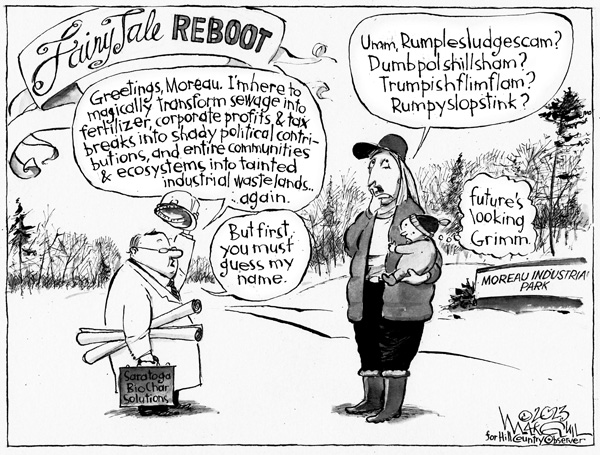Editorial February-March 2023
E D I T O R I A L
Many reasons to doubt biochar firm’s promise
For the sake of argument, let’s be charitable and assume for a moment that the developers who want to build a new sewage sludge-to-fertilizer plant in northern Saratoga County are sincerely trying to solve a pressing environmental problem while making a few dollars for themselves.
As our cover story this month details, the partners in a new venture called Saratoga Biochar Solutions claim their planned facility in the town of Moreau will be able to collect up to 15 percent of the municipal sewage sludge produced annually across New York state and transform it into an environmentally beneficial “carbon fertilizer.”
Sewage sludge, the collection of solids left over after municipal wastewater treatment, is bad stuff. It’s contaminated with every chemical that ever went down a drain – including heavy metals, pharmaceuticals and PFAS, a class of “forever chemicals” that are considered a human health hazard even at tiny concentrations. Most sewage sludge now winds up in landfills because no one has a better way to dispose of it.
Saratoga Biochar says it plans to use a process called pyrolysis, which involves extremely high temperatures in the absence of oxygen, to break down and remove contamination, leaving only a charcoal-like substance, biochar, that can be used as a beneficial soil amendment.
But when it comes to the crucial question of whether the company’s process really will remove all the contamination – and, therefore, whether the end product will be safe – the response of Saratoga Biochar’s founders is this: Trust us.
There are plenty of good reasons to be skeptical. The idea of exposing sewage sludge to high temperatures to remove contamination has been around for awhile and has tested in some demonstration projects, but so far the results of these efforts haven’t been particularly impressive. No one has attempted to pursue the concept on anything close to the scale Saratoga Biochar is planning.
And there is nothing to suggest that the company’s founders have a record of spearheading the kinds of technological advances that might be needed to make the process work. Quite the contrary: In a recent in-depth report, The Post-Star of Glens Falls reported that one of the Saratoga Biochar partners previously ran a business in Iowa that was accused of making its neighbors sick when it improperly stockpiled a large quantity of sewage sludge on a farm. Another worked for a Nebraska ethanol plant that was shut down by state regulators after repeated environmental violations; among other problems, the plant produced biochar that was contaminated with pesticides.
Saratoga Biochar’s response to this reporting has been to argue that its founders have learned from past mistakes.
Despite their past problems, however, the company’s founders now project an air of supreme confidence that their system for removing contaminants from sewage sludge, which has never operated at scale for even a single day, will function exactly as promised.
What if PFAS chemicals survive the heat treatment and persist in the biochar? Trust us, we guarantee 100 percent PFAS removal.
And what if the biochar winds up spreading contaminants to farm fields across the wider region? Trust us, it will never happen here.
Of course it’s possible that Saratoga Biochar might yet revolutionize the treatment of municipal sewage sludge. But as many townspeople in Moreau now suspect, when something sounds too good to be true, it probably is.


